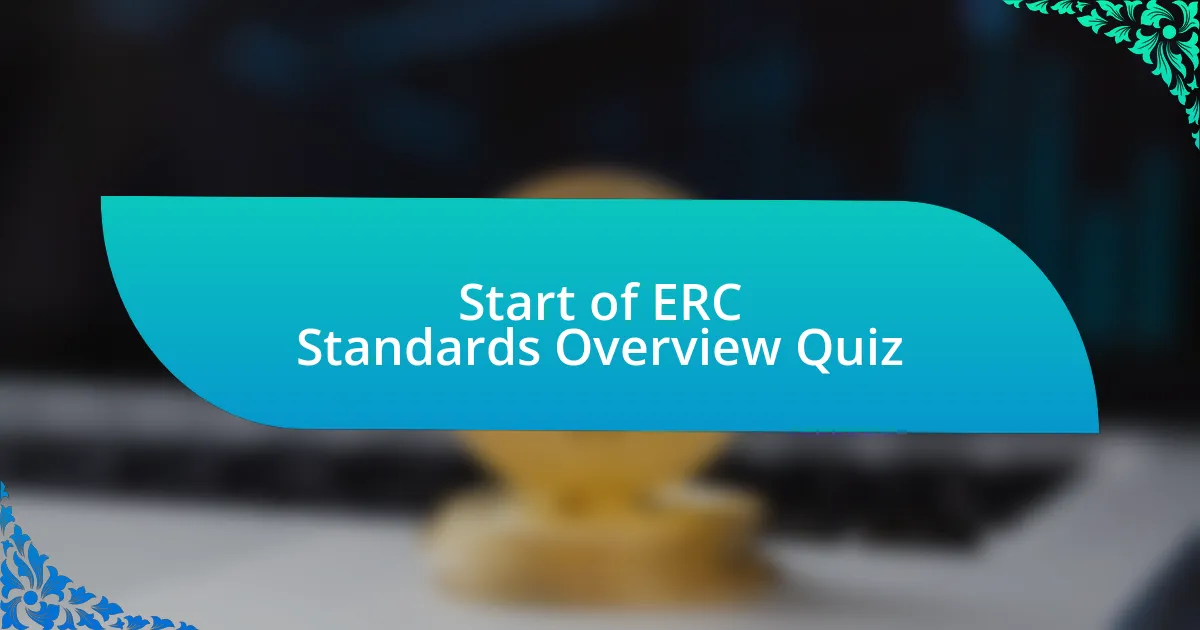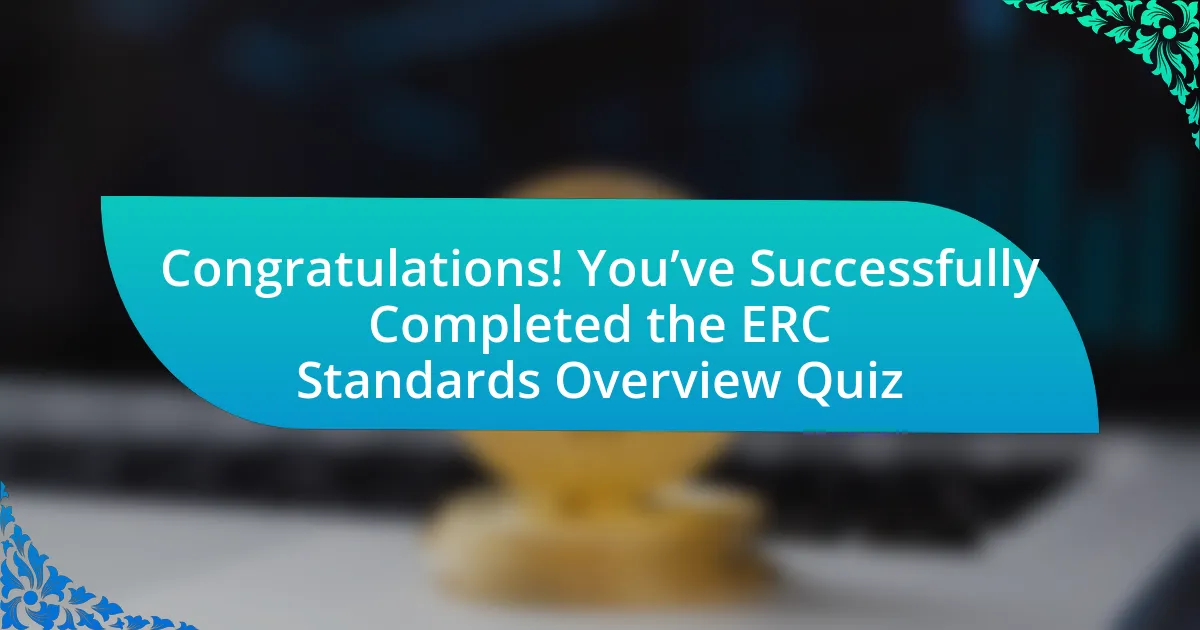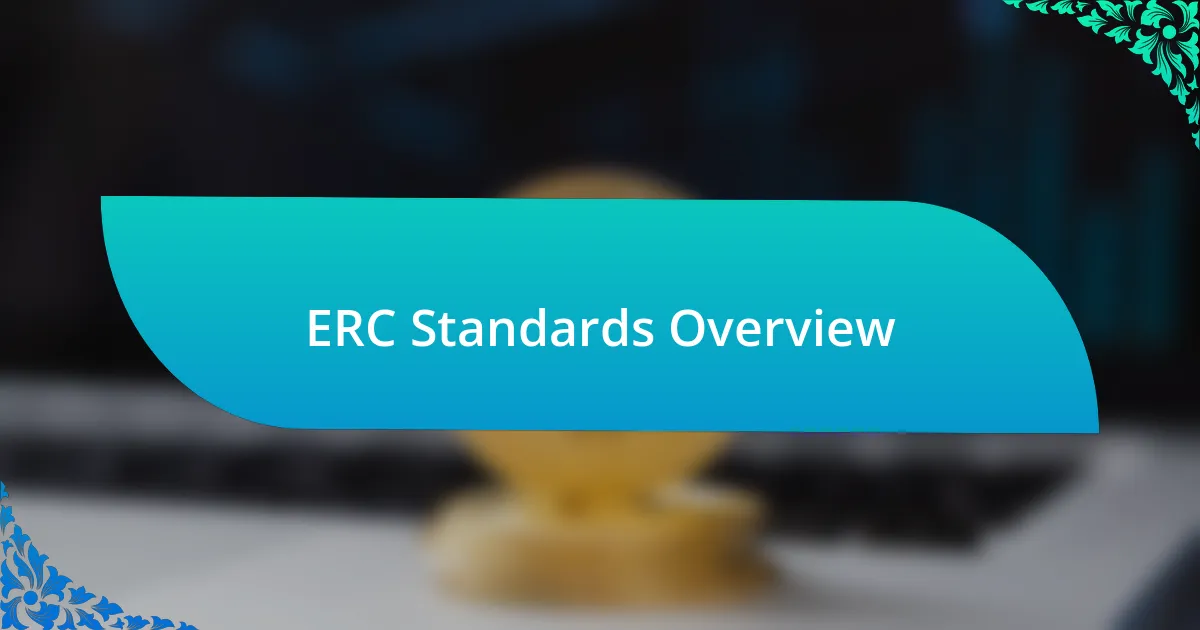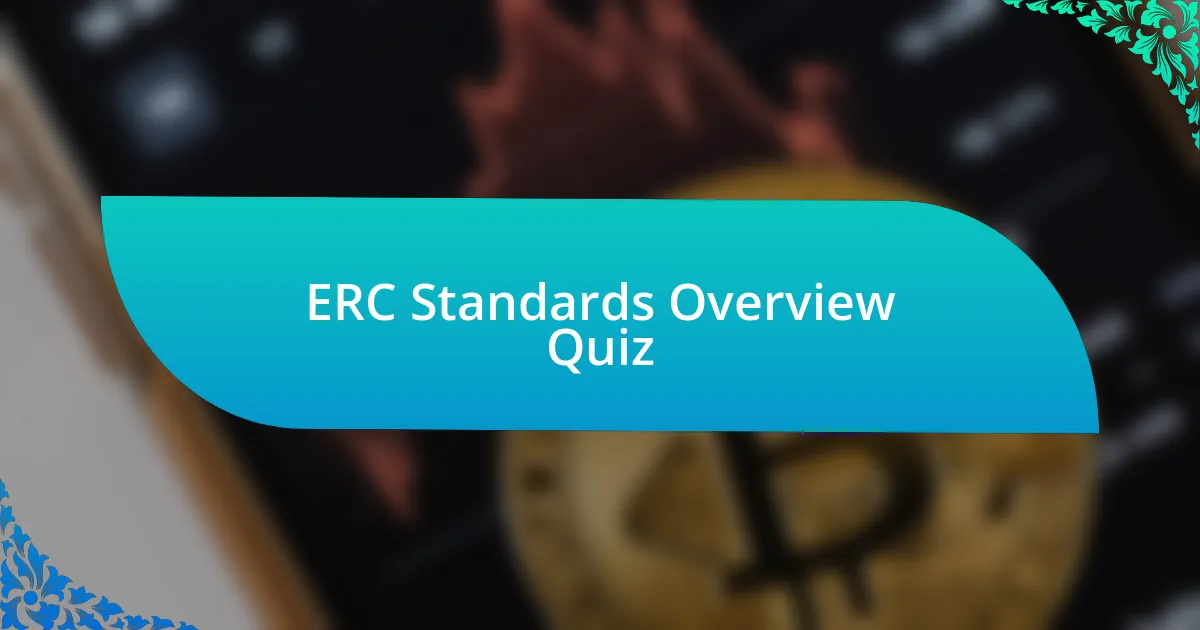
Start of ERC Standards Overview Quiz
1. What does ERC stand for in the context of Ethereum?
- Ethereum Resource Code
- Ethereum Request for Comments
- Ethereum Ready Components
- Ethereum Reference Case
2. What is the primary purpose of ERC standards?
- To establish patterns that make it easier for applications and contracts on the Ethereum network to interact with each other.
- To create a new type of cryptocurrency for general use.
- To enforce strict regulations on all Ethereum transactions.
- To limit the number of tokens available in the Ethereum ecosystem.
3. What is the first ERC token standard created on the Ethereum network?
- ERC-1155
- ERC-20
- ERC-777
- ERC-721
4. What type of tokens does ERC-20 enable?
- Fungible tokens.
- Non-fungible tokens.
- Staking tokens.
- Utility tokens.
5. What are the six mandatory functions for an ERC-20 compliant contract?
- createToken, freezeAccount, sellTokens, cashOut.
- issueTokens, distributeRewards, withdrawFunds, manageAssets.
- totalSupply, balanceOf, transfer, transferFrom, approve, and allowance.
- mintTokens, transferOwnership, executeTransaction, grantApproval.
6. What is the function of the totalSupply function in ERC-20?
- Returns the total supply of tokens.
- Retrieves user transaction history.
- Updates the token price based on market demand.
- Calculates the total transaction fees.
7. What is the function of the balanceOf function in ERC-20?
- Verifies the token`s ownership status.
- Allows the transfer of tokens between addresses.
- Returns the balance of tokens for a specific address.
- Calculates the total supply of tokens in circulation.
8. What is the function of the transfer function in ERC-20?
- Approves another address to spend tokens on behalf of the sender.
- Returns the balance of tokens for a specific address.
- Returns the total supply of tokens.
- Transfers tokens from the sender’s address to another address.
9. What is the function of the approve function in ERC-20?
- Allows the sender to create new tokens.
- Approves another address to spend tokens on behalf of the sender.
- Transfers tokens between two addresses.
- Returns the balance of a specific address.
10. What is the function of the transferFrom function in ERC-20?
- Sends tokens to the sender`s address instantly.
- Checks the balance of an address for the contract.
- Approves a contract to mint new tokens on behalf of the user.
- Transfers tokens from one address to another using the allowance mechanism.
11. What is the function of the allowance function in ERC-20?
- Transfers tokens from one address to another.
- Returns the balance of tokens held by the contract.
- Approves the total supply of tokens for an address.
- Returns the amount of tokens that an address is allowed to spend on behalf of another address.
12. What is ERC-721 used for?
- Establishing smart contracts for loans.
- Minting fungible tokens for trade.
- Creating non-fungible tokens (NFTs).
- Sending cryptocurrencies between wallets.
13. What is unique about NFTs created with ERC-721?
- All NFTs are identical and interchangeable.
- NFTs can be divided into smaller units like cryptocurrency.
- Each NFT can be tranferred only once.
- Each NFT is unique and not interchangeable.
14. What is ERC-1155 used for?
- Enabling only fungible tokens in separate contracts.
- Creating both fungible and non-fungible tokens within a single contract.
- Issuing security tokens exclusively in one contract type.
- Facilitating the storage of digital assets without smart contracts.
15. What is the primary benefit of using ERC-1155?
- It ensures only fungible tokens can be created in one contract.
- It simplifies the process of creating decentralized exchanges.
- It allows the creation of multiple types of tokens in a single contract.
- It limits tokens to just one type per contract.
16. What is ERC-777 used for?
- It creates unique tokens for digital collectibles.
- It reduces friction in crypto transactions by allowing a user to reject incoming tokens from a blacklisted address.
- It standardizes token creation for video games.
- It enables users to mine new cryptocurrencies easily.
17. What is the main improvement of ERC-777 over ERC-20?
- It restricts token transfers to only approved addresses and decreases the transaction speed.
- It simplifies the implementation of smart contracts and increases the token supply.
- It eliminates the need for any type of transaction fees and only supports fungible tokens.
- It allows for more complex token interactions and reduces the need for additional transactions.
18. What is ERC-1400 used for?
- Facilitating peer-to-peer lending directly.
- Building decentralized applications seamlessly.
- Creating, issuing, and trading security tokens.
- Managing supply chains effectively.
19. What is the significance of ERC-1400 in the context of security tokens?
- It provides a flexible and extensible set of standards for security token creation.
- It focuses solely on the trading of cryptocurrencies.
- It eliminates the need for blockchain technology in security token transactions.
- It establishes a fixed price for all security tokens.
20. What is ERC-621 used for?
- It enables the trading of security tokens across different platforms.
- It expands the functionality of ERC-20 and ERC-223 standards by allowing token creators to decrease or increase the total supply in circulation.
- It creates non-fungible tokens (NFTs) using the Ethereum blockchain.
- It manages the metadata of tokens created on the Ethereum network.
21. How does ERC-621 help in maintaining token economy?
- It helps by allowing token creators to adjust the supply, which can increase demand and potentially increase the token`s value.
- It sets a fixed supply for all tokens, ensuring price stability.
- It allows token holders to vote on supply adjustments through a consensus mechanism.
- It prohibits any changes to the number of tokens in circulation to maintain value.
22. What is the purpose of burning ERC-621 tokens?
- To store tokens securely in a cold wallet for future use.
- To create new tokens and expand the supply for trading.
- To decrease the token supply, increase demand, and potentially increase the token`s value.
- To convert tokens into regular currency at fixed rates.
23. What is the main difference between ERC-20 and ERC-721?
- ERC-20 allows for unique digital collectibles that can be sold individually.
- ERC-20 is used for creating multiple types of contracts all at once.
- ERC-20 is for fungible tokens, while ERC-721 is for non-fungible tokens (NFTs).
- ERC-721 tokens can be exchanged for each other without any difference.
24. What is the significance of ERC-165 in the context of ERC standards?
- It is a supporting pillar for ERC-721, ensuring that smart contracts implement specific interfaces to interact with tokens following other standards.
- It is a mechanism for converting ERC-20 tokens to ERC-721 tokens automatically.
- It defines a new type of token that is completely different from ERC-20 and ERC-721.
- It eliminates the need for compliance with existing ERC standards for developers.
25. What is the primary benefit of using ERC standards in the Ethereum ecosystem?
- Allowing only one type of token in a contract.
- Limiting transaction speeds on the Ethereum network.
- Ensuring interoperability and compatibility between different applications and wallets.
- Making Ethereum more centralized and easier to govern.
26. How do ERC standards promote interoperability?
- By limiting the interaction between different blockchain networks.
- By enforcing strict rules that prohibit any custom implementations.
- By creating exclusive token types that only specific applications can use.
- By providing a common framework and set of guidelines that developers can follow to ensure compatibility and interoperability.
27. What are the benefits of adopting ERC standards for token developers?
- Interoperability, simplified development, increased liquidity, compliance, and security.
- Reduced transaction fees, faster transaction speeds, high scalability, and user privacy.
- Limiting token creation, unique market positioning, data privacy measures, and centralized control.
- Exclusive access to private networks, automated trading bots, immutable contracts, and decentralized governance.
28. What is the role of the Ethereum Improvement Proposal (EIP) process in the development of ERC standards?
- The EIP process is used only for creating new programming languages.
- The EIP process is concerned exclusively with marketing strategies for Ethereum.
- The EIP process involves reviewing, commenting, and revising documents before they become finalized as ERC standards.
- The EIP process focuses on determining cryptocurrency prices.
29. How do ERC standards ensure that tokens are compatible with various applications and wallets?
- By establishing a unique identity for each token that cannot be changed.
- By allowing tokens to be created without any specific guidelines or rules.
- By creating a blacklist of addresses that cannot interact with tokens.
- By defining a set of rules and specifications that tokens must follow to ensure interoperability.
30. What is the significance of the interface structure for ERC-20, ERC-721, and ERC-1155 tokens?
- The interface structure defines the functions and events that need to be implemented in smart contracts to conform to each respective token standard.
- The interface structure determines the marketing strategies for token promotion.
- The interface structure outlines the legal requirements for issuing tokens.
- The interface structure specifies the security measures for token transactions.

Congratulations! You’ve Successfully Completed the ERC Standards Overview Quiz
Well done on finishing the quiz about ERC Standards! This journey not only tested your knowledge but also helped you gain clarity on important concepts related to ERC Standards. You may have learned how these standards impact various sectors, enhance interoperability, and promote innovation. Each question aimed to reinforce your understanding of key principles and their real-world applications.
Quizzes like this serve as a fantastic way to assess your grasp of complex topics. They can illuminate areas where further learning might be beneficial. Reflecting on the questions you answered can enhance your comprehension of ERC Standards. Remember, every bit of knowledge boosts your ability to apply these standards effectively in various contexts.
Ready to dive deeper? We invite you to explore the next section on this page for comprehensive information about ERC Standards Overview. It’s perfect for expanding your knowledge and solidifying what you’ve learned in this quiz. Your learning journey doesn’t stop here—continue to explore and enhance your expertise!

ERC Standards Overview
Introduction to ERC Standards
ERC standards refer to a set of technical specifications created for the Ethereum blockchain. These standards provide guidelines for the development of smart contracts and token interactions. They ensure interoperability and consistency across various applications. By adhering to these standards, developers can create reliable and secure blockchain solutions.
Types of ERC Standards
There are several types of ERC standards, each serving a specific purpose within the Ethereum ecosystem. The most well-known is ERC-20, which defines a standard for fungible tokens. Other notable standards include ERC-721, for non-fungible tokens (NFTs), and ERC-1155, which allows for both fungible and non-fungible token management. Each standard outlines specific functions that make token interaction seamless.
Importance of ERC-20 Standard
ERC-20 is crucial as it sets the foundation for creating fungible tokens on the Ethereum platform. It simplifies the process of token creation and integration. By establishing standard functions, it allows easy transfer and exchange of tokens on various platforms. ERC-20 tokens are widely used in Initial Coin Offerings (ICOs) and decentralized applications, enhancing usability within the Ethereum network.
ERC-721 and Non-Fungible Tokens
ERC-721 introduces the concept of non-fungible tokens, which are unique and not interchangeable. This standard provides specifications for ownership, transfers, and metadata of individual items. It has enabled the creation of digital collectibles and art, significantly impacting the NFT market. Each token under ERC-721 represents a distinct asset, ensuring authenticity and ownership traceability.
Future of ERC Standards
The future of ERC standards includes ongoing developments to address scalability and functionality. New standards may emerge to enhance features such as privacy and interoperability across blockchains. As the blockchain landscape evolves, ERC standards will likely adapt to meet the changing needs of developers and users, maintaining relevance in the rapidly advancing technology sector.
What are ERC Standards?
ERC Standards, or Ethereum Request for Comment Standards, are technical specifications for Ethereum-based tokens and smart contracts. They define a set of rules and guidelines that developers should follow to ensure interoperability and standardization within the Ethereum ecosystem. The most widely known ERC standards include ERC-20 for fungible tokens and ERC-721 for non-fungible tokens (NFTs). These standards facilitate the creation and exchange of digital assets on the Ethereum blockchain.
How do ERC Standards work?
ERC Standards work by outlining a specific set of functions and events that a token or smart contract must implement. When developers create new tokens, adhering to these standards guarantees that the tokens can be easily interacted with by wallets, exchanges, and other contracts. For instance, ERC-20 defines methods for transferring tokens and checking account balances, ensuring a consistent experience across various applications. This uniformity is critical for user adoption and broader ecosystem functionality.
Where are ERC Standards used?
ERC Standards are primarily used within the Ethereum blockchain ecosystem. They are implemented in various decentralized applications (dApps), wallets, exchanges, and other platforms that require standard token behavior. Projects launching ICOs (Initial Coin Offerings) often utilize ERC-20 as a framework for their tokens, while digital art and collectibles commonly employ ERC-721 standards to create and trade NFTs. This widespread usage enables seamless transactions and interactions across differing platforms.
When were ERC Standards established?
ERC Standards were established starting in 2015 when the Ethereum network first launched. The ERC-20 standard was introduced in November 2015, establishing guidelines for fungible tokens. Over the years, other standards, such as ERC-721 in January 2018, were developed to address specific needs within the ecosystem, such as uniquely identifiable digital assets. These standards have since evolved and expanded as the Ethereum community continues to innovate.
Who maintains ERC Standards?
ERC Standards are maintained by the Ethereum community, particularly through a collaborative process involving developers and stakeholders. The Ethereum Improvement Proposal (EIP) process allows anyone to propose new standards or modifications to existing ones. These proposals are publicly discussed and debated within the community and are subsequently reviewed for consideration. The Ethereum Foundation plays a significant role in facilitating this process, but the maintenance of standards is a collective endeavor.

